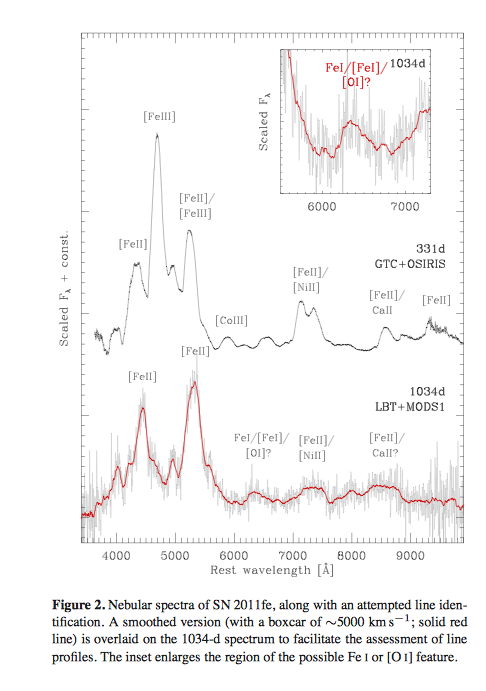Padova-Asiago Supernova Group
Highlights
Spectroscopy of the Type Ia supernova 2011fe past 1000 days
Taubenberger, S. etal. 2015, MNRAS 448, L48 (link to pdf)
In this letter we present an optical spectrum of SN 2011fe taken 1034 d after the explosion, several hundred days later than any other spectrum of a Type Ia supernova (disregarding light-echo spectra and local-group remnants). The spectrum is still dominated by broad emission features, with no trace of a light echo or interaction of the supernova ejecta with surrounding interstellar material. Comparing this extremely late spectrum to an earlier one taken 331 d after the explosion, we find that the most prominent feature at 331 d - [Fe III] emission around 4700 A - has entirely faded away, suggesting a significant change in the ionisation state. Instead, [Fe II] lines are probably responsible for most of the emission at 1034 d. An emission feature at 6300-6400 A has newly developed at 1034 d, which we tentatively identify with Fe I {\lambda}6359, [Fe I] {\lambda}{\lambda}6231, 6394 or [O I] {\lambda}{\lambda}6300, 6364. Interestingly, the features in the 1034-d spectrum seem to be collectively redshifted, a phenomenon that we currently have no convincing explanation for. We discuss the implications of our findings for explosion models, but conclude that sophisticated spectral modelling is required for any firm statement 30
Taubenberger, S. etal. 2015, MNRAS 448, L48 (link to pdf)
In this letter we present an optical spectrum of SN 2011fe taken 1034 d after the explosion, several hundred days later than any other spectrum of a Type Ia supernova (disregarding light-echo spectra and local-group remnants). The spectrum is still dominated by broad emission features, with no trace of a light echo or interaction of the supernova ejecta with surrounding interstellar material. Comparing this extremely late spectrum to an earlier one taken 331 d after the explosion, we find that the most prominent feature at 331 d - [Fe III] emission around 4700 A - has entirely faded away, suggesting a significant change in the ionisation state. Instead, [Fe II] lines are probably responsible for most of the emission at 1034 d. An emission feature at 6300-6400 A has newly developed at 1034 d, which we tentatively identify with Fe I {\lambda}6359, [Fe I] {\lambda}{\lambda}6231, 6394 or [O I] {\lambda}{\lambda}6300, 6364. Interestingly, the features in the 1034-d spectrum seem to be collectively redshifted, a phenomenon that we currently have no convincing explanation for. We discuss the implications of our findings for explosion models, but conclude that sophisticated spectral modelling is required for any firm statement 30
